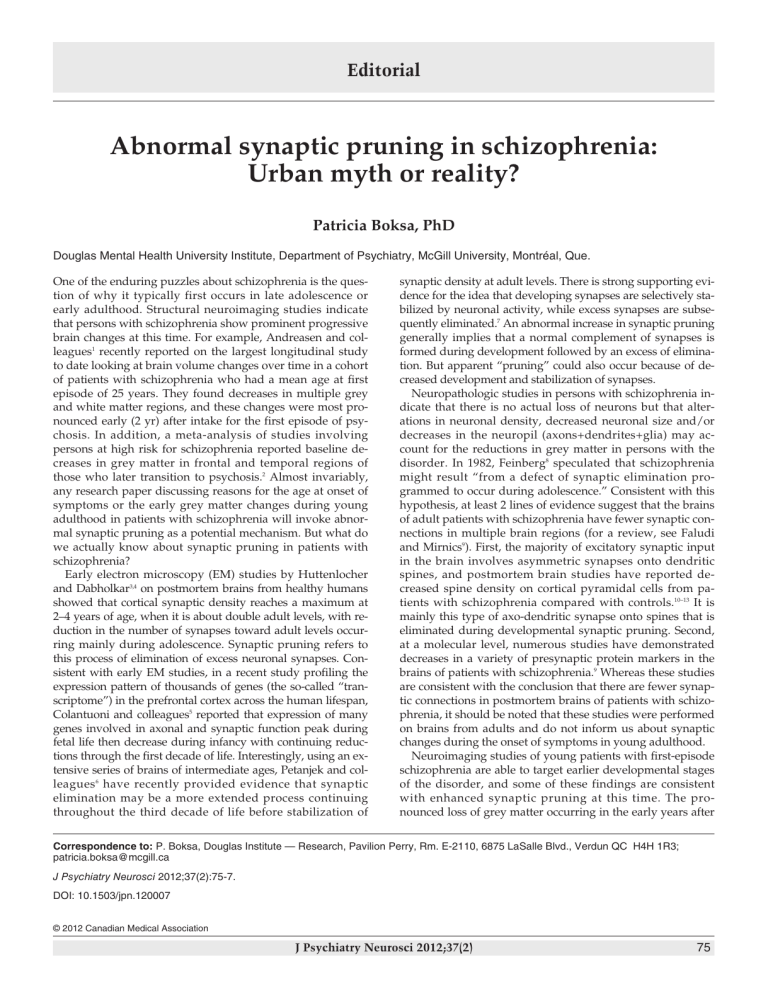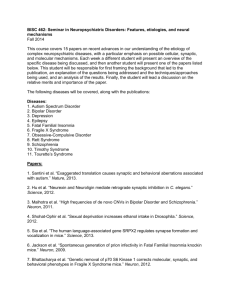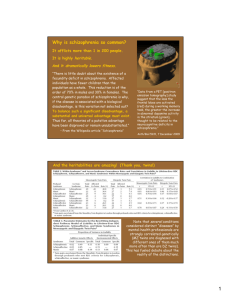Abnormal synaptic pruning in schizophrenia
advertisement

Editorial Abnormal synaptic pruning in schizophrenia: Urban myth or reality? Patricia Boksa, PhD Douglas Mental Health University Institute, Department of Psychiatry, McGill University, Montréal, Que. One of the enduring puzzles about schizophrenia is the question of why it typically first occurs in late adolescence or early adulthood. Structural neuroimaging studies indicate that persons with schizophrenia show prominent progressive brain changes at this time. For example, Andreasen and colleagues1 recently reported on the largest longitudinal study to date looking at brain volume changes over time in a cohort of patients with schizophrenia who had a mean age at first episode of 25 years. They found decreases in multiple grey and white matter regions, and these changes were most pronounced early (2 yr) after intake for the first episode of psychosis. In addition, a meta-analysis of studies involving persons at high risk for schizophrenia reported baseline decreases in grey matter in frontal and temporal regions of those who later transition to psychosis.2 Almost invariably, any research paper discussing reasons for the age at onset of symptoms or the early grey matter changes during young adulthood in patients with schizophrenia will invoke abnormal synaptic pruning as a potential mechanism. But what do we actually know about synaptic pruning in patients with schizophrenia? Early electron microscopy (EM) studies by Huttenlocher and Dabholkar3,4 on postmortem brains from healthy humans showed that cortical synaptic density reaches a maximum at 2–4 years of age, when it is about double adult levels, with reduction in the number of synapses toward adult levels occurring mainly during adolescence. Synaptic pruning refers to this process of elimination of excess neuronal synapses. Consistent with early EM studies, in a recent study profiling the expression pattern of thousands of genes (the so-called “transcriptome”) in the prefrontal cortex across the human lifespan, Colantuoni and colleagues5 reported that expression of many genes involved in axonal and synaptic function peak during fetal life then decrease during infancy with continuing reductions through the first decade of life. Interestingly, using an extensive series of brains of intermediate ages, Petanjek and colleagues 6 have recently provided evidence that synaptic elimination may be a more extended process continuing throughout the third decade of life before stabilization of synaptic density at adult levels. There is strong supporting evidence for the idea that developing synapses are selectively stabilized by neuronal activity, while excess synapses are subsequently eliminated.7 An abnormal increase in synaptic pruning generally implies that a normal complement of synapses is formed during development followed by an excess of elimination. But apparent “pruning” could also occur because of decreased development and stabilization of synapses. Neuropathologic studies in persons with schizophrenia indicate that there is no actual loss of neurons but that alterations in neuronal density, decreased neuronal size and/or decreases in the neuropil (axons+dendrites+glia) may account for the reductions in grey matter in persons with the disorder. In 1982, Feinberg8 speculated that schizophrenia might result “from a defect of synaptic elimination programmed to occur during adolescence.” Consistent with this hypothesis, at least 2 lines of evidence suggest that the brains of adult patients with schizophrenia have fewer synaptic connections in multiple brain regions (for a review, see Faludi and Mirnics9). First, the majority of excitatory synaptic input in the brain involves asymmetric synapses onto dendritic spines, and postmortem brain studies have reported decreased spine density on cortical pyramidal cells from patients with schizophrenia compared with controls.10–13 It is mainly this type of axo-dendritic synapse onto spines that is eliminated during developmental synaptic pruning. Second, at a molecular level, numerous studies have demonstrated decreases in a variety of presynaptic protein markers in the brains of patients with schizophrenia.9 Whereas these studies are consistent with the conclusion that there are fewer synaptic connections in postmortem brains of patients with schizophrenia, it should be noted that these studies were performed on brains from adults and do not inform us about synaptic changes during the onset of symptoms in young adulthood. Neuroimaging studies of young patients with first-episode schizophrenia are able to target earlier developmental stages of the disorder, and some of these findings are consistent with enhanced synaptic pruning at this time. The pronounced loss of grey matter occurring in the early years after Correspondence to: P. Boksa, Douglas Institute — Research, Pavilion Perry, Rm. E-2110, 6875 LaSalle Blvd., Verdun QC H4H 1R3; patricia.boksa@mcgill.ca J Psychiatry Neurosci 2012;37(2):75-7. DOI: 10.1503/jpn.120007 © 2012 Canadian Medical Association J Psychiatry Neurosci 2012;37(2) 75 Boksa the onset of schizophrenia, described by Andreasen and colleagues,1 coincides with the time in normal human development when synaptic pruning is prominent. Using longitudinal magnetic resonance imaging (MRI) to look at brain surface contraction, Sun and colleagues14 showed greater contraction in the dorsal frontal lobe of patients with firstepisode schizophrenia compared with controls. Overall, however, brain surface contraction showed a similar anatomic pattern in patients and controls, supporting the idea that patients were exhibiting an exaggeration of the normal developmental loss of brain volume. Phosphorous-31 magnetic resonance spectroscopy (MRS) has been used to examine phospholipid metabolism in the brains of patients with schizophrenia, with phosphomonoesters (PMEs) being involved in membrane phospholipid synthesis and phosphodiesters (PDEs) being involved in membrane phospholipid breakdown. Two studies imaging medication-naive patients with first-episode schizophrenia and with mean ages of 24 and 26 years, respectively, found decreased levels of PMEs and increased PDEs in the prefrontal cortex,15,16 whereas studies imaging older patients with schizophrenia (mean ages 29, 32, 37, 37 and 43 years, respectively) failed to find an increase in PDEs in cortical regions.16–19 Increased brain levels of PDEs in the younger patients is probably one of the more direct pieces of evidence suggesting increased membrane breakdown, possibly owing to enhanced synaptic elimination in the early stages of schizophrenia. Finally, a recent metaanalysis looked at MRS studies of brain N-acetylaspartate (NAA), a metabolite thought to be an indicator of neuronal/axonal loss or neuronal metabolism. Decreased NAA levels were found in frontal and temporal lobes of patients with first-episode and those with chronic schizophrenia, with only a trend for a temporal lobe decrease in patients at risk for psychosis, leading the authors to speculate that alterations in NAA might occur in the transition between the at-risk stage and the first episode.20 Whereas these findings on NAA may be consistent with enhanced synaptic pruning during early-stage schizophrenia, the precise significance of reduced NAA levels is open to interpretation given the involvement of NAA in a multiplicity of neuronal functions.21 Basic science studies have succeeded in outlining molecular mechanisms determining synaptic density during normal brain development, and abnormalities in some of these pathways have been implicated in patients with schizophrenia. As mentioned, the presynaptic bouton of most excitatory synapses abuts onto a dendritic spine, which is a small protuberance containing an actin cytoskeleton, glutamate receptors and other proteins regulating synaptic function. A large body of evidence supports the concept that excitatory activity mediated by the N-methyl-D-aspartate (NMDA) subtype of glutamate receptor is a major factor determining stabilization of synapses. N-methyl-D-aspartate receptor activation modulates cytoskeletal dynamics, regulates expression of structural proteins and neurotrophins, such as brain-derived neurotrophic factor (BDNF), that promote synapse stabilization, and recruits α-amino-3-hydroxy-5-methyl-4-isoxazolepropionic acid (AMPA) receptors, which support spine maintenance.22,23 The actin cytoskeleton, which determines spine morphology and 76 hence synaptic function, is also highly regulated by a family of small RhoGTPases (RhoA, Rac1, Cdc42), which cycle between activation by guanine nucleotide exchange factors (GEFs) and inhibition by GTPase-activating proteins.24 A well-known candidate gene for schizophrenia, DISC1, has recently been shown to interact with one of these GEFs, called Kalirin-7, limiting activation of Rac1, whereas NMDA receptor activation causes dissociation of DISC1 from Kalirin-7, enabling Rac1 activation.25 This interaction of DISC1 with regulators of the actin cytoskeleton may account for the loss of dendritic length and spine density observed in DISC1 mutant mice.26 Other proteins, which have been shown to be reduced in the postmortem brains of persons with schizophrenia, may also plausibly interact with mechanisms regulating synaptic stability and elimination. For example, Hill and colleagues27 have reported that prefrontal cortex tissue from patients with schizophrenia contained decreased levels of messenger RNA (mRNA) for RhoGTPase Cdc42 and for Duo, the human ortholog of mouse Kalirin-7, suggesting that decreased expression of these proteins may affect actin dynamics and hence spine density in patients with schizophrenia.28 As another example, reelin is a glycoprotein reported to be reduced in the brains of patients with schizophrenia, whereas dendritic spine density has been shown to be reduced in reelin-deficient rodent models. Phosphorylation of the F-actin binding protein, n-cofilin, inhibits its actin-severing activity, leading to stabilization of the cytoskeleton, and recently it has been shown that signalling by reelin is required for n-cofilin phosphorylation.29 Thus, in patients with schizophrenia, reduced reelin may reduce cytoskeleton stability and dendritic spine density via a decrease in n-cofilin phosphorylation. As a final example, BDNF is a neurotrophic protein implicated in the maintenance of spine density in some brain regions. Several studies have observed reduced BDNF protein and mRNA levels in patients with schizophrenia and, in one report, levels of BDNF mRNA correlated positively with spine density in the prefrontal cortex of such patients.30,31 This background provides plausible mechanisms for involvement of proteins like Cdc42, reelin or BDNF in synaptic stability in patients with schizophrenia. However, it should be noted that reduced expression of these proteins has been observed in postmortem brains from adult patients, and nothing is known about the status of these molecules in the brains of young adults with first-episode schizophrenia (when synaptic pruning is proposed to be aberrant). Moreover, merely showing reduced levels of one of these proteins certainly doesn’t prove its involvement in aberrant synaptic pruning in patients with schizophrenia. Finally, recent findings reported in Science might serve as a reminder that we still have much to learn about the basic process of synaptic pruning even in normal development. In an intriguing set of experiments, Paolicelli and colleagues32 provided novel evidence for involvement of microglia in synaptic pruning by showing that these cells can engulf synaptic material in the uninjured developing mouse brain. Moreover, they showed that knockout of the receptor for the chemokine fractalkine, which is necessary for microglial J Psychiatry Neurosci 2012;37(2) Abnormal synaptic pruning in schizophrenia 15. Pettegrew JW, Keshavan MS, Panchalingam K, et al. Alterations in brain high-energy phosphate and membrane phospholipid metabolism in first-episode, drug-naive schizophrenics. A pilot study of the dorsal prefrontal cortex by in vivo phosphorus 31 nuclear magnetic resonance spectroscopy. Arch Gen Psychiatry 1991;48:563-8. 16. Stanley JA, Williamson PC, Drost DJ, et al. An in vivo study of the prefrontal cortex of schizophrenic patients at different stages of illness via phosphorus magnetic resonance spectroscopy. Arch Gen Psychiatry 1995;52:399-406. 17. Volz HP, Rzanny R, Rössger G, et al. 31Phosphorus magnetic resonance spectroscopy of the dorsolateral prefrontal region in schizophrenics — a study including 50 patients and 36 controls. Biol Psychiatry 1998;44:399-404. 18. Yacubian J, de Castro CC, Ometto M, et al. 31P-spectroscopy of frontal lobe in schizophrenia: alterations in phospholipid and high-energy phosphate metabolism. Schizophr Res 2002;58:117-22. 19. Andreasen NC, Nopoulos P, Magnotta V, et al. Progressive brain change in schizophrenia: a prospective longitudinal study of firstepisode schizophrenia. Biol Psychiatry 2011;70:672-9. Smesny S, Rosburg T, Nenadic I, et al. Metabolic mapping using 2D 31P-MR spectroscopy reveals frontal and thalamic metabolic abnormalities in schizophrenia. Neuroimage 2007;35:729-37. 20. Fusar-Poli P, Borgwardt S, Crescini A, et al. Neuroanatomy of vulnerability to psychosis: a voxel-based meta-analysis. Neurosci Biobehav Rev 2011;35:1175-85. Brugger S, Davis JM, Leucht S, et al. Proton magnetic resonance spectroscopy and illness stage in schizophrenia — a systematic review and meta-analysis. Biol Psychiatry 2011;69:495-503. 21. Huttenlocher PR. Synaptic density in human frontal cortex — developmental changes and effects of aging. Brain Res 1979;163: 195-205. Moffett JR, Ross B, Arun P, et al. N-Acetylaspartate in the CNS: from neurodiagnostics to neurobiology. Prog Neurobiol 2007;81:89131. 22. Hua JY, Smith SJ. Neural activity and the dynamics of central nervous system development. Nat Neurosci 2004;7:327-32. Huttenlocher PR, Dabholkar AS. Regional differences in synaptogenesis in human cerebral cortex. J Comp Neurol 1997;387:167-78. 23. Colantuoni C, Lipska BK, Ye T, et al. Temporal dynamics and genetic control of transcription in the human prefrontal cortex. Nature 2011;478:519-23. McKinney RA. Excitatory amino acid involvement in dendritic spine formation, maintenance and remodelling. J Physiol 2010;588: 107-16. 24. Petanjek Z, Judaš M, Šimic G, et al. Extraordinary neoteny of synaptic spines in the human prefrontal cortex. Proc Natl Acad Sci U S A 2011;108:13281-6. Tolias KF, Duman JG, Um K. Control of synapse development and plasticity by Rho GTPase regulatory proteins. Prog Neurobiol 2011; 94:133-48. 25. Hayashi-Takagi A, Takaki M, Graziane N, et al. Disrupted-inSchizophrenia 1 (Drosoph Inf ServC1) regulates spines of the glutamate synapse via Rac1. Nat Neurosci 2010;13:327-32. 26. Lee FH, Kaidanovich-Beilin O, Roder JC, et al. Genetic inactivation of GSK3α rescues spine deficits in Disc1-L100P mutant mice. Schizophr Res 2011;129:74-9. 27. Hill JJ, Hashimoto T, Lewis DA. Molecular mechanisms contributing to dendritic spine alterations in the prefrontal cortex of subjects with schizophrenia. Mol Psychiatry 2006;11:557-66. migration, caused deficient synaptic pruning and an excess of dendritic spines and immature synapses. These experiments introduce a range of new candidate mechanisms involving microglial function that could contribute to aberrant synaptic pruning in patients with schizophrenia. In closing, I would conclude that abnormal synaptic pruning remains an attractive hypothesis in schizophrenia, but we remain rather remote from its proof. Nonetheless, if it is in fact abnormal, synaptic pruning could represent an interesting target for therapeutic intervention in patients with schizophrenia, given our increasing understanding of the mechanisms involved in normal synaptic stabilization and pruning. Competing interests: None declared. References 1. 2. 3. 4. 5. 6. 7. Hua JY, Smith SJ. Neural activity and the dynamics of central nervous system development. Nat Neurosci 2004;7:327-32. 8. Feinberg I. Schizophrenia: Caused by a fault in programmed synaptic elimination during adolescence? J Psychiatr Res 19821983;17:319-34. 9. Faludi G, Mirnics K. Synaptic changes in the brain of subjects with schizophrenia. Int J Dev Neurosci 2011;29:305-9. 10. Glantz LA, Lewis DA. Decreased dendritic spine density on prefrontal cortical pyramidal neurons in schizophrenia. Arch Gen Psychiatry 2000;57:65-73. 28. Ide M, Lewis DA. Altered cortical CDC42 signaling pathways in schizophrenia: implications for dendritic spine deficits. Biol Psychiatry 2010;68:25-32. 11. Garey L. When cortical development goes wrong: schizophrenia as a neurodevelopmental disease of microcircuits. J Anat 2010;217: 324-33. 29. Chai X, Förster E, Zhao S, et al. Reelin stabilizes the actin cytoskeleton of neuronal processes by inducing n-cofilin phosphorylation at serine3. J Neurosci 2009;29:288-99. 12. Kalus P, Müller TJ, Zuschratter W, et al. The dendritic architecture of prefrontal pyramidal neurons in schizophrenic patients. Neuroreport 2000;11:3621-5. 30. Balu DT, Coyle JT. Neuroplasticity signaling pathways linked to the pathophysiology of schizophrenia. Neurosci Biobehav Rev 2011; 35:848-70. 13. Broadbelt K, Byne W, Jones LB. Evidence for a decrease in basilar dendrites of pyramidal cells in schizophrenic medial prefrontal cortex. Schizophr Res 2002;58:75-81. 31. Hill JJ, Kolluri N, Hashimoto T, et al. Analysis of pyramidal neuron morphology in an inducible knockout of brain-derived neurotrophic factor. Biol Psychiatry 2005;57:932-4. 14. Sun D, Stuart GW, Jenkinson M, et al. Brain surface contraction mapped in first-episode schizophrenia: a longitudinal magnetic resonance imaging study. Mol Psychiatry 2009;14:976-86. 32. Paolicelli RC, Bolasco G, Pagani F, et al. Synaptic pruning by microglia is necessary for normal brain development. Science 2011; 333:1456-8. J Psychiatry Neurosci 2012;37(2) 77







